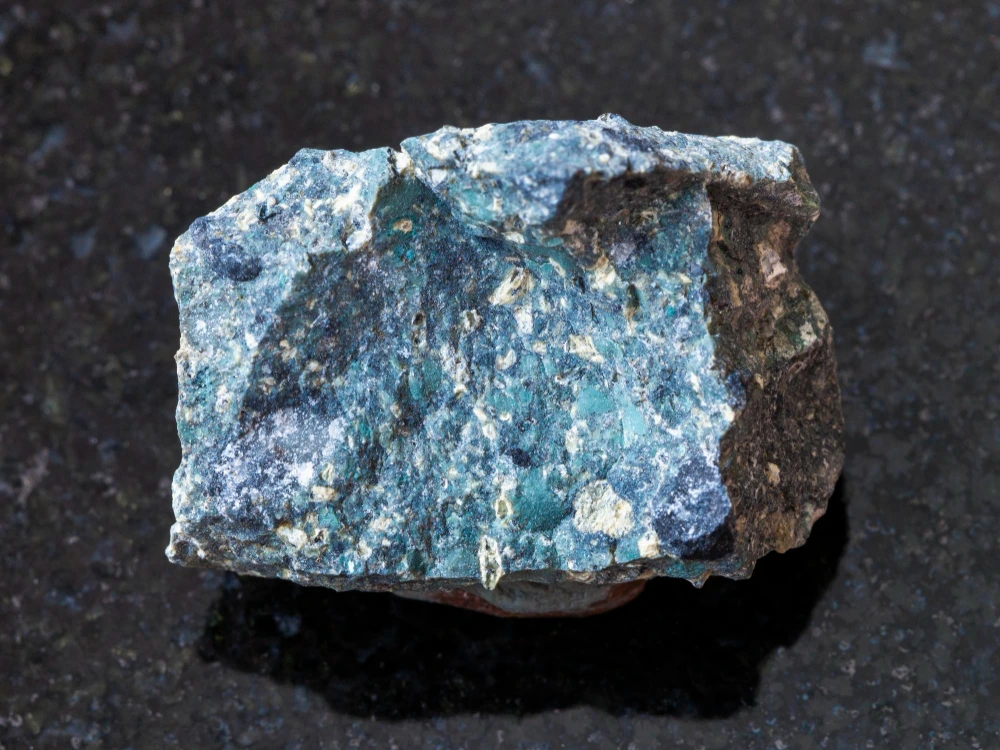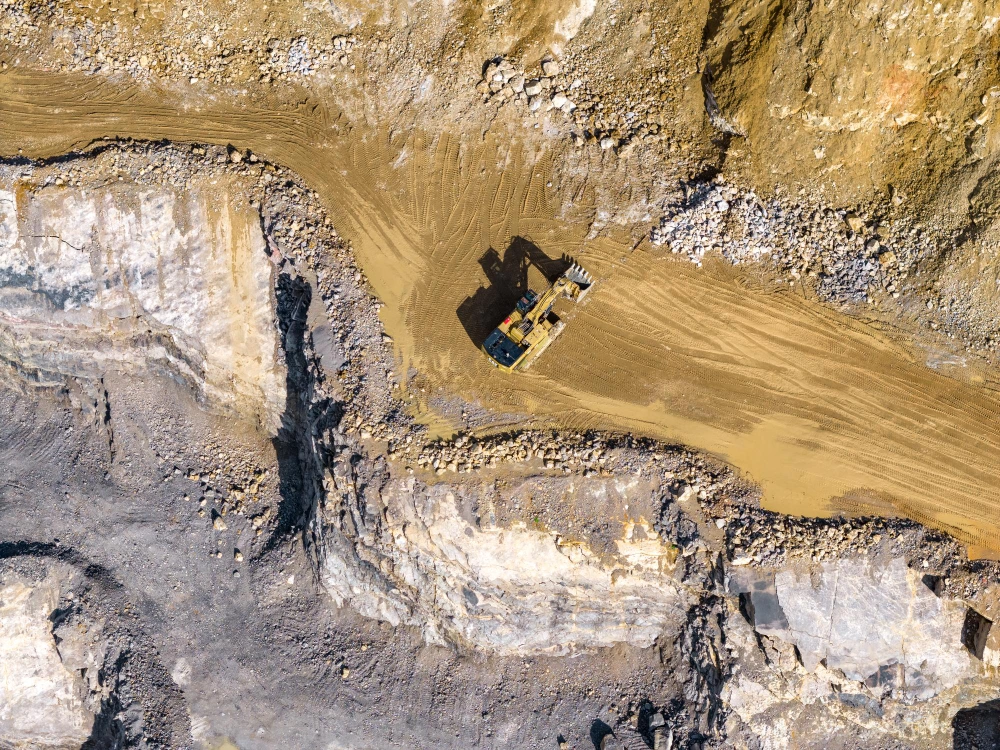Contents
Diamond mining involves locating diamond-bearing ores and extracting them through mining methods like open-pit mining or underground mining. The process covers exploring, extracting, and processing diamond ores, as well as sorting rough diamonds. This article guides you through every step of the diamond mining process.
What is diamond mining?
Diamond mining is the process of extracting diamonds from the earth using methods such as open-pit mining for surface deposits and underground mining for deeper, below-surface deposits. Alluvial mining and marine mining are also used when one wants to extract rough diamonds from riverbeds or the ocean floor.
As a mineral, diamonds are highly valuable, but the mining process is criticized for its negative social and environmental impacts, such as human rights breaches, disruptions to local communities, and deforestation.
Diamond-bearing ore: Kimberlite
Before a diamond becomes a valuable part of a jewelry piece, it lives within a diamond-bearing ore. Ores are naturally occurring rocks that contain valuable minerals, from which metals or precious stones like diamonds are extracted. The most common diamond-bearing ore is kimberlite.
What is a kimberlite?
A kimberlite is a rare, igneous rock that originates deep in the Earth’s mantle. It’s the primary host rock for diamonds.
What does a kimberlite look like?
Kimberlite is a dark and heavy rock with a specific texture that looks like embedded crystals. They are sourced from kimberlite pipes, which are volcanic formations formed by explosive eruptions of magma and rock.

Types of diamond mining
Diamond mining is done through many different methods. It is either performed in large-scale mining operations, such as open-pit or underground mining, or smaller-scale mining operations, like alluvial or marine mining.
Open-pit diamond mining
As a large-scale mining exploration and extraction method, open-pit mining is applicable when the diamond-bearing ore lies close to the surface. The open-pit mining process includes digging large pits from the surface that enables one to remove layers of earth and expose diamond-bearing ore. Thereafter, the ores are blasted, and with the help of excavators, they are loaded into trucks for transportation to the crusher for processing.
Learn more about open-pit mining here
Underground diamond mining
If the diamond-bearing ores are not close to the surface and the expected diamond deposits are too deep for an open-pit mining operation, one chooses the underground mining technique. It involves digging tunnels into the earth to reach the ore, which, once discovered, is blasted, collected, and brought to the surface for extraction.
Read more about underground mining here
Alluvial diamond mining
Alluvial mining is a method that involves building a large wall to collect the water in one area. It belongs to the broader category of placer mining. One expects to find diamonds in the gravel layer, which collects under layers of other material, such as mud or clay. The prerequisite for alluvial diamond mining is to determine whether an area is expected to bear diamond deposits. Over time, the surface is eroded by wind and rain making it possible for rough diamonds to be carried in streams. The gravel is collected, hauled to the surface, and prepared for processing.
Marine diamond mining
Marine mining operations involve extracting diamonds from the seabed. Rough diamonds are hiding hundreds of meters underwater, and while shore diving was normal in the past, today, one uses specialized ships to crawl and suck the gravel through pipes and drills.

The diamond mining process
The diamond mining process, regardless of the mining technique being deployed, is considered an eight step process. From drilling and processing diamond ores to extracting rough diamonds, the steps are as follows:
- Exploring
- Drilling
- Collection
- Crushing (processing)
- Scrubbing (processing)
- Separation (processing)
- Recovery
- Cleaning
Exploring sites for diamond deposits
The starting point is, as with any mining process, to identify areas where diamond deposits are likely to occur. Geologists use methods like remote sensing, geological mapping, and sampling to find kimberlite pipes containing diamond ores. Once the area is discovered, assessed, and mapped out, and the geological samples have been proved to be promising, then the drilling can commence.
Learn more about the mineral exploration phase
Drilling for diamond ore
During mining, the diamond-bearing ores are drilled using various techniques. The choice of drilling method impacts how the ores are discovered, extracted, and transported.
- Open-pit mining
- Underground mining
- Alluvial mining
- Marine mining
Do you know what directional drilling is? Understand why it useful here
Collection
Diamond-bearing ore is collected from the mines and transported to the processing plant.
Processing
The processing stage covers crushing, scrubbing, and separation (steps 3-5).
Crushing
The first step of the processing stage is to crush the diamond ores and break them into smaller pieces. The diamond bearing ore is transported to a crusher, where the primary crusher is responsible for reducing the size of the ore into smaller pieces. These should be no larger than 150 mm. The secondary crusher is used when it’s necessary to reduce the size of the ore even further.
Scrubbing
Next, the ore is scrubbed to remove loose, excess material. All the ores are screened to separate out different sizes. Material smaller than 1,5 mm is discarded because it’s too costly to extract diamonds from such small pieces.
Separation
The final step of the processing stage is the separation of diamond-bearing ores to expose the rough diamonds. At a cyclonic separation plant, the ore goes through separation techniques that use density to isolate the diamonds.
The ores are mixed with a solution of ferrosilicon powder and water, which is measured to a specific, relative density and fed into a cyclone. The cyclone tumbles the material and forces a separation. Materials with high density sink to the bottom, making visible a diamond-rich concentrate. Being denser, diamonds are naturally separated from lighter waste materials.
Cleaning and packing
The rough diamonds are cleaned in an acid solution, washed further, and weighed. They are sorted based on size, shape, quality and color. Afterward, they are packaged in a sealed container and transported. It’s a requirement that the containers must be sealed with a tamper resistant seal, that they are numbered, and a certificate of origin be issued.
Recovery
The concentrate is put through a wide variety of processes to separate the rough diamond from any other heavy density materials collected in the cyclonic separation plant. Such processes include magnetic susceptibility, X-ray luminescence, and crystallographic laser fluorescence.

Why can diamond mining be unethical?
Historically, there have been human rights concerns related to diamond mining and the diamond industry as a whole. This includes allegations of forced labor and displacement of local communities.
The social impacts of diamond mining industry
Human rights issues
There have been reports of forced and/or child labor, as well as poor working conditions in some mines, particularly in African countries.
Community displacement
Large-scale mining operations can disrupt local communities’ daily life and force them to relocate. It can also limit their access to clean water, daily activities, or cultural, traditional way of life.
Conflict and instability
In some cases, diamonds have been linked to funding civil wars and armed conflicts. These diamonds are known as blood diamonds.
Is diamond mining bad for the environment?
Diamond mining can in many cases be considered bad for the environment. The risk of deforestation, wildlife habitat loss, air and water pollution, as well as local community disruptions are proven risks to the environment. As many of these factors are direct consequences of large-scale mining operations, many prefer lab grown diamonds. They can be a more sustainable option, having a lower environmental impact and risk of human rights breaches.
The environmental impacts of diamond mining industry
Deforestation
As large-scale mining operations require extensive land clearing, it often leads to deforestation and harms wildlife nearby.
Habitat deconstruction
There is a risk of losing habitats for local wildlife when executing diamond mining operations.
Water contamination
Due to chemicals that are harmful to people and animals, the water supply can be compromised as a result of diamond mining. Polluted water supply affects both local communities and wildlife.
Historical perspective
Early diamond trading
The diamond trade originated in India, where one traces diamond trading back as early as the 4th century BC. Later, in the 17th century, India had become a hub for diamond mining and trading.
Discovery of diamonds in Africa
Major diamond deposits were discovered in South Africa in the late 1800s, which propelled the diamond mining industry to search for and discover diamond deposits in other nearby countries on the continent as well. Diamond mines were soon established in Botswana and the Democratic Republic of the Congo, among other countries.
Modern diamond mining
Today, diamonds are being mined in several countries like the aforementioned South Africa and Botswana, as well as Australia. Due to modern technologies like advanced drilling equipment and specialized ships or machines, the exploration, mining, and processing of diamond-bearing ores and rough diamonds have become very effective.
Continue reading
Advanced borehole steering technology in mining
Aziwell is a leading provider of directional drilling solutions and offers service, rental, and software products for directional drilling. At the heart of this is our advanced borehole steering technology, which reduces the environmental footprint through fewer drill pads, operational time, and CO₂ emissions. Our borehole steering is precise, does not require special rods or rigs, and has no depth limitations.



